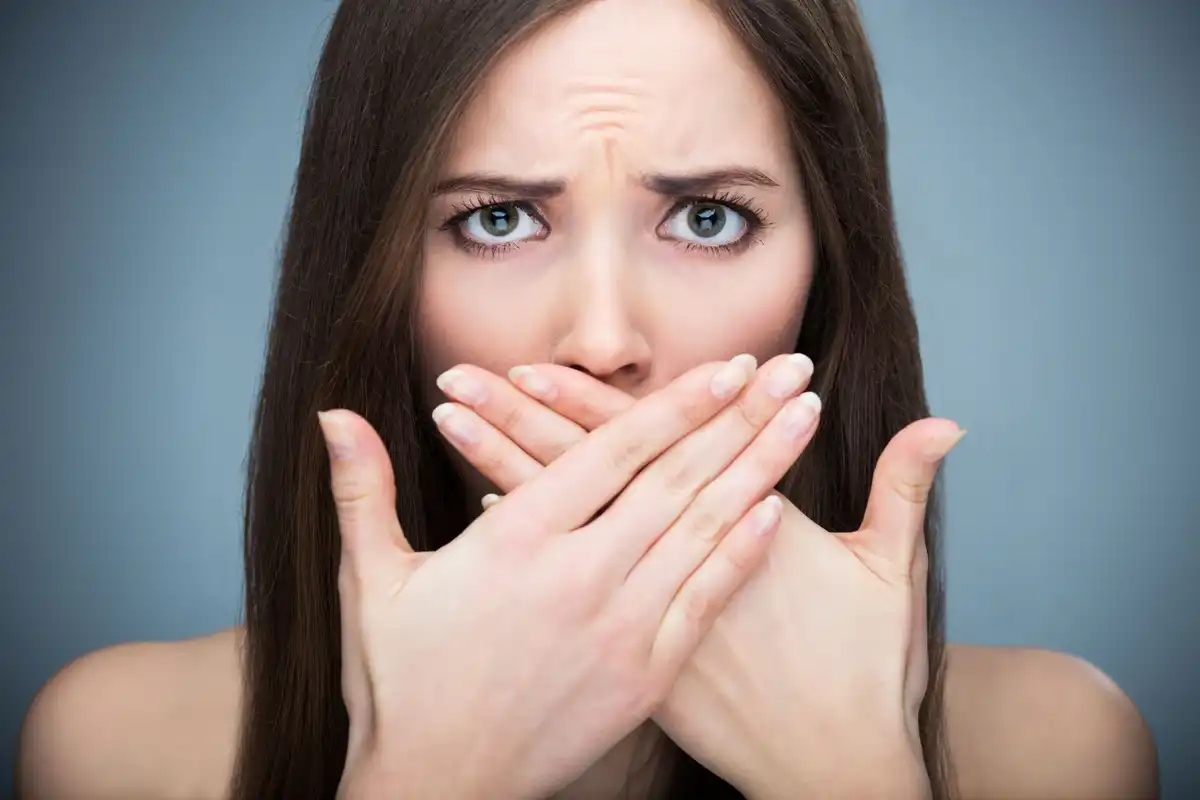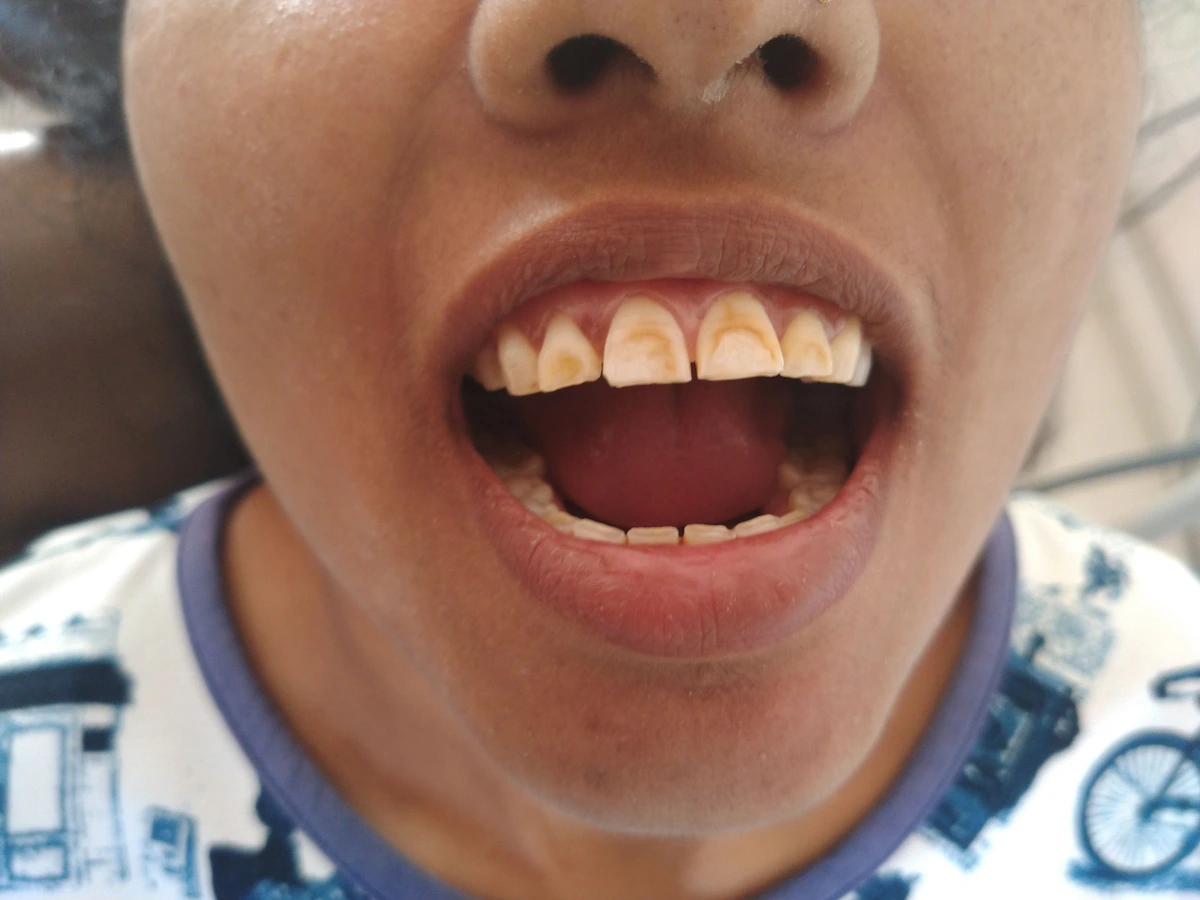11 Reasons Why You Have Brown Spots On Your Teeth


Having dark discoloration or brown spots on teeth can detract from your smile’s appearance. If you’re someone who has teeth with brown stains on them, understanding the cause can help you prevent them from getting worse (or get rid of them altogether.) Depending on the source, it could be entirely superficial (extrinsic) or a structurally internal (intrinsic) stain.
Common Symptoms
As you might suspect, brown spots on teeth are fairly easy to diagnose. Especially in your “smile zone” that’s visible when you’re posing for selfies or looking in the mirror. But the stains can happen anywhere, especially behind your upper front teeth (if you’re a smoker) or in the chewing surfaces of your back ones, where there are deep grooves and pits. If your diet tends to have a lot of coffee, tea, red wine, or soda in it, you’ll likely see more stain than someone’s that isn’t.
Common Causes
There is a plethora of reasons why some people have teeth with brown stains and others don’t. Identifying the sources of tooth discoloration is important because it’s the first step in finding the best way to get rid of and prevent additional stain buildup. If you’re not sure what’s causing it, here are some popular risk factors to start ruling out.
1) Tobacco Products
Cigarettes, cigars, and smokeless tobacco can cause heavy brown stains on teeth in no time. They also take longer to clean off during your checkup appointments!
Symptoms
Smokers tend to see the heaviest amount of stain just behind their upper front teeth. The tissues on the roof of your mouth will also look abnormal. And if you’re using dip/snuff, the stain may be thicker where you’re holding the smokeless tobacco.
Treatment
This type of brown stain on teeth can be polished off during your six-month checkups. But it also tends to soak deeper into your enamel over time, requiring professional whitening treatments to get rid of it.
2) Food & Drinks
Coffee, tea, red wine, soda, sports drinks, dark berries, pasta sauce…you name it. If it’s dark and would stain a white t-shirt, it can also stain your teeth.
Symptoms
Eating or drinking these types of foods/beverages every now and then won’t cause severe brown stains. But if consumed regularly, they can start to build up and get worse. If you’re currently whitening your teeth, be sure to avoid these items as your tooth may soak them up quicker than normal.
Treatment
Limiting your exposure to teeth-staining foods is the first step. After meals, step away to thoroughly rinse your mouth with water. When possible, drink through a straw.
3) Severe Fluorosis
Symptoms
Signs and symptoms of fluorosis usually aren’t evident until each set of teeth starts to erupt, depending on when the exposure took place. The tooth can have mild discoloration to severe enamel irregularities.
Treatment
Treating fluorosis depends on the extent of the damage and may be cosmetic or restorative in nature. Aesthetic veneers are helpful, but full-coverage crowns may be necessary.
4) Tartar Buildup
Calcified plaque – aka “tartar” or “calculus” – is that rocky buildup that forms on your teeth when you don’t brush or floss thoroughly enough. It’s also porous, making it a magnet for stain and discoloration.
Symptoms
It’s normal for most of us to get a little tartar between dental cleanings. But if you can see the buildup, you’re probably past due for a checkup or could even have gum disease. The stain will be heaviest along your gumlines and behind your lower front teeth.
Treatment
Schedule a professional cleaning with your dental hygienist. If the tartar is super heavy, you may need more of a deep cleaning because of the buildup that’s also under your gums.
5) Age
The older we get, the more stain our teeth absorb from our food and the overall environment. Just like changes in our skin, we see aging in our teeth! Especially as enamel wears down and exposes more of the inner layer of the tooth known as “dentin.”
Symptoms
Generally speaking, your teeth will take on a darker or more yellow appearance that affects the entire surface.
Treatment
Professional or over-the-counter whitening treatments can lift away several shades of stain, making your teeth appear younger.
6) Medications
Different types of medications can stain your teeth, especially if they’re a liquid or taken during tooth development. For example, chlorhexidine rinse may be used to help treat gum disease, but if you use it excessively it can lead to brown stains on teeth.
Symptoms
Ingested medications taking during pregnancy or childhood may not show internal staining until the permanent teeth erupt. Otherwise, you may notice stains accumulating after a couple of weeks of use.
Treatment
Always follow manufacturer’s directions and communicate with your doctor or dentist. If the stain is superficial, it can be polished off during your dental cleaning.
7) Enamel Hypoplasia
When your tooth doesn’t have enough of the right vitamins/minerals inside of it, or there’s a particular type of medical syndrome or congenital defect, it can lead to permanent changes in your tooth during development.
Symptoms
Treatment
The only treatment for hypoplasia is to cover the compromised tooth structure for cosmetic or structural purposes. A crown or veneer may be recommended.
8) Celiac Disease
Symptoms
Dentally speaking, there may be white or brown spots on teeth. But celiac disease is also known for causing chronic gastrointestinal distress, specifically after eating foods with gluten in them.
Treatment
Most people with celiac disease respond well to changes in their diet (specifically the elimination of gluten.) Working with your gastroenterologist or autoimmune specialist is key.
9) Pool Or Lap Swimming
Competitive and recreational swimmers may see brown stains on their teeth when they’re spending more time at the pool. It’s thought that the chlorine or other makeup of the pool water cause the stain.
Symptoms
If you have kids that swim, you may not notice any stains on their teeth until towards the end of the summer. But for year-round swimmers, the accumulation could build up every few months.
Treatment
Rinse your mouth well with tap water after swimming and brush your teeth when you get home. Schedule regular cleanings to have stain polished off.
10) Vitamins And Supplements
If you or your child are taking multi-vitamins, you may notice something called “black line stain” start to gradually build up. This type of stain doesn’t affect everyone, but a small percentage of people are prone to it.
Symptoms
Blackline stain usually accumulates along the gumlines, causing dark brown or black residue.
Treatment
Again, this type of stain is usually one that you can have your hygienist polish off when it’s time to get your teeth cleaned.
11) Recreational Drugs
Inhaled recreational drugs and vaping can cause heavy stain on your front teeth. For instance, marijuana is known for causing more greenish-colored stains and it’s heavier on your upper front teeth, due to where people hold the joint.
Symptoms
The more often you use recreational drugs, the heavier amount of stain you’ll see on your teeth. Keep in mind, things such as vaping or drug use can also increase your risk of tooth decay (which may look like brown stain.)
Treatment
Depending on why you’re using recreational drugs – such as for pain management – be sure to speak with your medical provider. It’s best that you don’t use them, but if you are, you’ll want to make sure you have a great oral hygiene plan set in place.
Preventing Brown Spots On Your Teeth
White or brown spots on your teeth are better prevented than treated after the fact. Understanding what puts you at risk can limit the amount of stain buildup, so that your teeth can stay brighter for longer. Although you might not be able to completely prevent or avoid what’s causing your stain, you can at least take steps to prevent it from getting too heavy. Here are some great ways to get started:
- avoid tobacco products, vaping, or other recreational drugs
- brush twice a day
- floss the side of each tooth once per day
- rinse your mouth after consuming dark foods/beverages
- schedule a dental cleaning at least once every six months
- sip through a straw if you’re drinking dark liquids
- rinse your mouth out after swimming
- adjust medications under the direction of your doctor and/or dentist
- using maintenance products such as whitening toothpaste
- investing in an electric toothbrush (some brands have whitening modes)
- drinking water between meals
When To See A Dentist
Do you have teeth with brown stains on them? Aside from discoloration, are you also suffering from sensitivity or toothaches? Having brown spots on teeth can be a cosmetic concern, but it could also indicate that a tooth is dying or had a cavity. Larger areas of decay tend to be brown, while early stages look more like white spots. An exam and X-ray will quickly determine what the cause of the stain is and if it’s something you need to worry about.

Your dentist can let you know if the brown stain is something that’s safe enough to bleach away with a whitening product, or if you require some type of physical treatment, such as a filling. If whitening is an option, the product can help you erase more internal tooth stain and keep new discoloration at bay (as long as you use your whitening kit for maintenance purposes.)
Bottom line make it a habit to see your dentist on a regular basis (at least twice a year) to have your teeth cleaned. This will give you a brighter smile so that if problems do pop up between visits, they’re easier and quicker to diagnose.
Overcoming Brown Stains On Your Teeth
When there are teeth with brown stains, it could be a strictly cosmetic issue or an indication that there’s something more serious going on (like tooth decay.) With good oral hygiene every day, limiting the amount of dark foods and beverages you consume, and scheduling routine cleanings, you can erase and minimize tooth discoloration. But when there are internal changes in your tooth’s structure, your dentist can give you other options to help – such as dental veneers or crowns. When in doubt, talk to your dentist!

Make your inbox smile!
Subscribe






